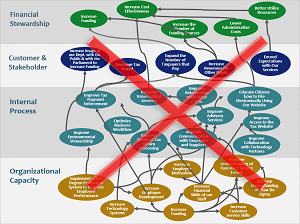 One of our clients decided to build their strategy map and balanced scorecard themselves after some training. They created a draft strategy map with 12 strategic objectives, linked together in a cause-effect chain–the strategy map–that showed how value was being created for their customers and the owners of the business. A few months after the training, the number went from 12 objectives to 32. Why? – a lack of discipline around the strategy development process and a feeling by a few folks who did not attend training that “more is better”.
One of our clients decided to build their strategy map and balanced scorecard themselves after some training. They created a draft strategy map with 12 strategic objectives, linked together in a cause-effect chain–the strategy map–that showed how value was being created for their customers and the owners of the business. A few months after the training, the number went from 12 objectives to 32. Why? – a lack of discipline around the strategy development process and a feeling by a few folks who did not attend training that “more is better”.
How many strategic objectives should there be on a strategy map? Ten, fifteen, twenty? Are more objectives better? How many are too many? How few are too few?
A strategy map is a visual representation of a strategy—it’s a hypothesis of what an organization has to do to create value for its customers and owners. For a private sector business, the owners are the shareholders; for a mission-driven organization — nonprofit or government — the “owners” at the end of the value chain are the benefiting stakeholders, e.g., members of an association, citizens of a government.
Strategic objectives, when connected in cause-effect links, represent a strategy hypothesis that can be tested and progress monitored using strategic measures of performance—KPIs—developed as part of the strategy development process. A good strategy map requires good objectives.
Objectives are used to identify measurable strategic intended results; develop KPIs that measure strategy progress; identify, prioritize and track actionable initiatives; build employee accountability; and communicate corporate vision and strategy internally and externally. We’ve identified a set of best practices for creating strategic objectives and strategy maps from our training and consulting engagements worldwide:
- Objectives are not start/stop activities or projects (those are initiatives)…objectives are continuous improvement activities that work together to produce value
- Twelve to 14 objectives are a good number for a corporate strategy map (organization size doesn’t matter here)
- Objectives indicate action and the potential for continuous improvement (Remember: strategic objectives are the DNA of your strategy—they make strategy actionable and understandable throughout the organization.)
- Objectives should be balanced among the four perspectives in a scorecard
- Objectives are “altitude sensitive”—if the strategic altitude is too high, it’s hard to translate “lofty” language into employee action…if too low, objectives will be framed in operational, not strategic, language
- Prioritized strategic initiatives, linked to each objective, should propel the organization forward toward its goals and vision
- Objectives should be measurable based on the associated intended results, to monitor progress toward accomplishment
Arguably one of the most important contributions to the science of management in the past two decades, strategy maps communicate the organization’s value proposition with clarity, both internally to employees so they can see how they “fit” in the organization, and externally to boards and other stakeholders.
Get strategic objectives and your strategy map right and your balanced strategic plan and strategy story will come alive quickly and clearly. These tools can help take your organization to the next level of performance.
You can learn more about strategic objectives and strategy mapping by reading our book, The Institute Way: Simplify Strategic Planning and Management with the Balanced Scorecard, or by attending one of our worldwide training classes.
Howard Rohm is President & Co-Founder of Balanced Scorecard Institute, a Strategy Management Group company. Howard is an author, performance management trainer and consultant, technologist, and keynote speaker with over 40 years’ experience.

